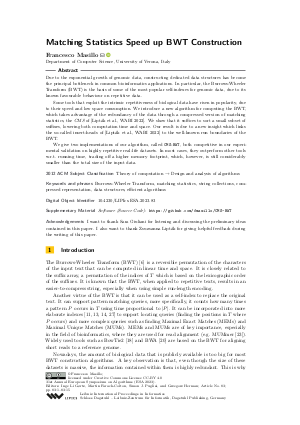@InProceedings{masillo:LIPIcs.ESA.2023.83,
author = {Masillo, Francesco},
title = {{Matching Statistics Speed up BWT Construction}},
booktitle = {31st Annual European Symposium on Algorithms (ESA 2023)},
pages = {83:1--83:15},
series = {Leibniz International Proceedings in Informatics (LIPIcs)},
ISBN = {978-3-95977-295-2},
ISSN = {1868-8969},
year = {2023},
volume = {274},
editor = {G{\o}rtz, Inge Li and Farach-Colton, Martin and Puglisi, Simon J. and Herman, Grzegorz},
publisher = {Schloss Dagstuhl -- Leibniz-Zentrum f{\"u}r Informatik},
address = {Dagstuhl, Germany},
URL = {https://drops.dagstuhl.de/entities/document/10.4230/LIPIcs.ESA.2023.83},
URN = {urn:nbn:de:0030-drops-187360},
doi = {10.4230/LIPIcs.ESA.2023.83},
annote = {Keywords: Burrows-Wheeler Transform, matching statistics, string collections, compressed representation, data structures, efficient algorithms}
}

 Creative Commons Attribution 4.0 International license
Creative Commons Attribution 4.0 International license




























